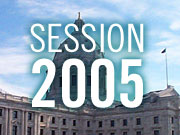| ||||||||||||||||||||||||||||||||
July 18, 2005
Gov. Pawlenty says he's willing to consider legislation that would prevent another government shutdown. Minnesota was not alone in failing to make a July first budget deadline. But other states that went into overtime have a safety net that keeps government from shutting down, even if the lawmakers can't get their work done on time. That safety net is starting to look good to the governor and some Minnesota legislators.
St. Paul, Minn. — Gov. Pawlenty was in Iowa last weekend attending the National Governors Association's annual meeting. It's a convocation of state chief executives. It's also a support group for the budgetarily challenged.
"Most of the other governors have had similar circumstances in the sense that they didn't get their budgets in on time," Gov. Pawlenty explained. "Or they had partisan gridlock to the point where it's been delayed."
Pawlenty says other state leaders at the conference were all too familiar with the kind of budgetary impasse that forced Minnesota's government into partial shutdown for 8 days. States such as California and Pennsylvania also failed to meet their July 1st budget deadlines. But several states -- eight nationwide -- have a fallback: a mechanism called a continuing resolution. It permits a state government to continue operating for a limited amount of time with the previous year's budget numbers until there's agreement on a new budget.
"In Minnesota, we didn't have that, which is one of the things we might want to consider for the future," Pawlenty said.
Other Republican lawmakers are echoing this idea. Rep. Greg Davids, R-Preston, says he has introduced a bill for next year that would establish such a continuing resolution.
But the Republicans' flirtation with the idea of a continuing resolution does come as a bit of a surprise, given their opposition to DFL "lights on" bills. Republican leaders maintained that those proposals would remove the urgency of finishing the budget right away.
Republican House Speaker Steve Sviggum has not departed from that view, nor does he readily embrace the concept of a continuing resolution mechanism.
"I would have to be sold on the idea," he says. "Right now I would be very hesitant, maybe even in opposition, because it seems to me that a continuing resolution idea institutionalizes gridlock, maybe institutionalizes and supports not being able to make a decision."
Political science professor Chris Gilbert of Gustavus Adolphus College doesn't see it that way. He says such a mechanism would not relieve the urgency of Minnesota's budget negotiations.
"There would still be a lot of public and political pressure to actually get the thing done on time. Because you know if you don't get it done on time, people will still think the governor and the legislature aren't doing their job," Gilbert says.
DFL Senate Majority Leader Dean Johnson says he's open to the idea of a continuing resolution. But he points out there are other options to consider, such as limiting the number of bills lawmakers can introduce.
"This idea of introducing a bill simply to have a press release and cover one's tracks back home with a constituency, we should begin to limit those kinds of things," he argues.
Johnson says there are too many bills and too many distractions.
"We're spending our time on lesser issues as opposed to what the central duty of the Legislature should be, which is to wrestle and set its biennial budget," according to Johnson.
Johnson says he hopes he'll have a chance to sit down with Gov. Pawlenty and Speaker Sviggum in the coming weeks to talk about ways to make the next budget process work more smoothly. So far, nothing's scheduled.




